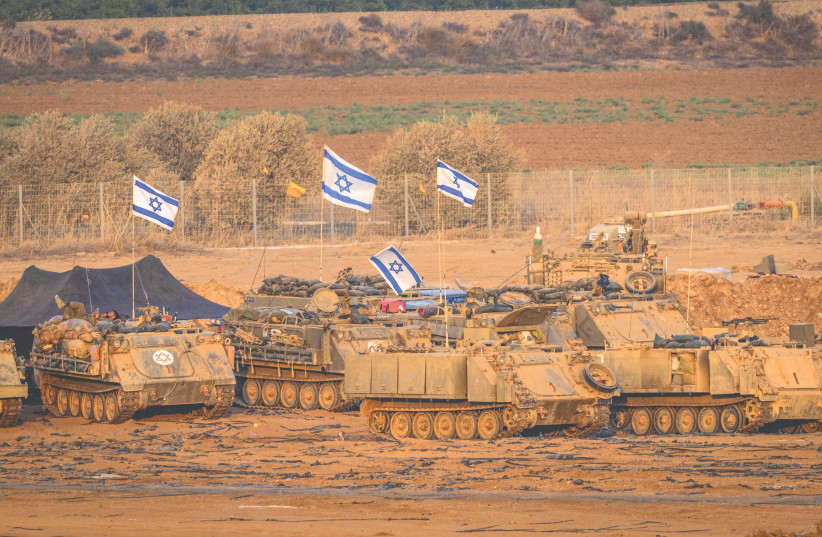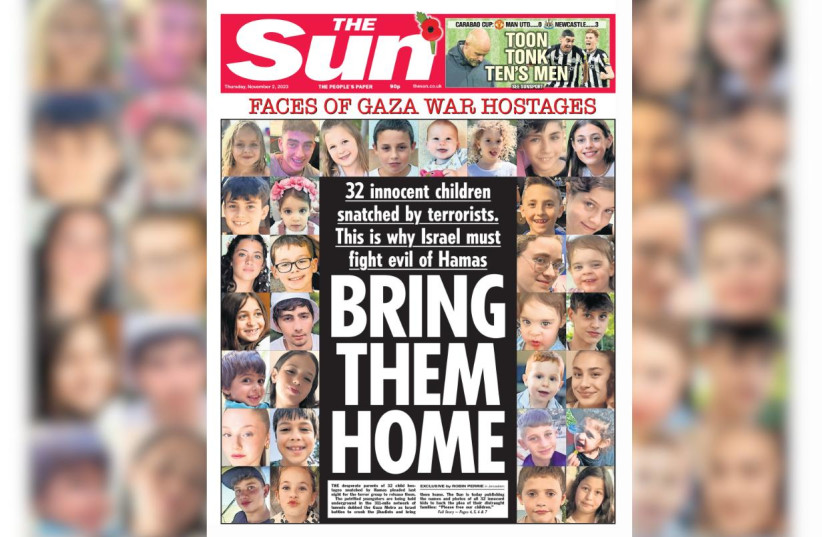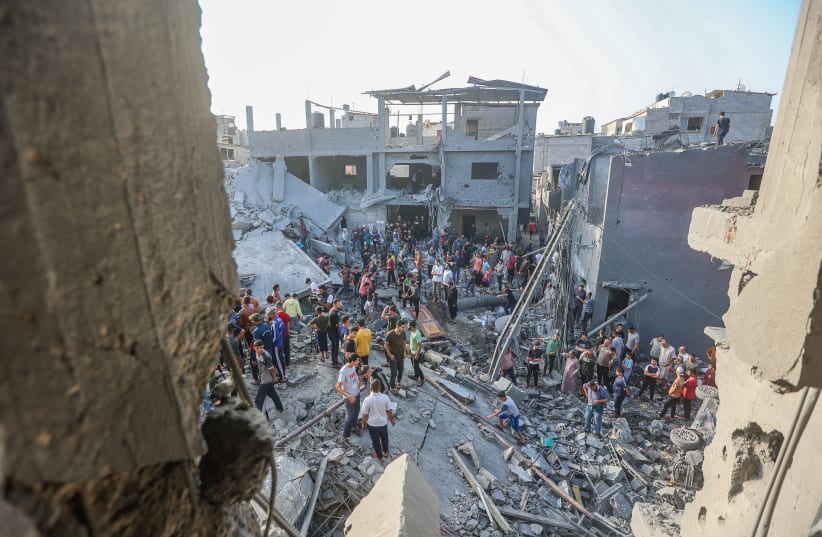Israel agreed to a daily four-hour pause in the fighting in northern Gaza as Palestinian Islamic Jihad published a video of two of the hostages it indicated could be released.
“We’ve been told by the Israelis that there will be no military operations in these areas over the duration of the pause,” US National Security Council spokesperson John Kirby said, adding that “this process is starting today.”
The localized pauses limited to specific areas in northern Gaza would allow people to flee along two humanitarian corridors and were significant first steps, Kirby explained.
The United States and Israel have been at odds over the details relating to humanitarian pauses, including the length of their duration, particularly given that such steps have been linked and are expected to be linked to the release of over 239 hostages held in Gaza.
Israel is looking to avoid a situation in which the fighting in Gaza is repeatedly halted due to such pauses thereby increasing the timeline of the war, and preventing it from achieving its military objective of ousting Hamas from the coastal enclave.

US President Joe Biden told reporters he had asked for a three-day pause in Gaza. Prime Minister Benjamin Netanyahu, however, had preferred one that lasted for an hour or two.
Biden told reporters as he left the White House for a campaign stop on Thursday that he had sought a longer pause.
“I’ve asked for a pause longer than three days.”
Four-hour pauses with three-hour notice
Asked if he was frustrated with Netanyahu, Biden said, “It’s taken a little longer than I hoped.”
Kirby said the agreement on a daily humanitarian pause emerged out of discussions between US and Israeli officials in recent days, including talks between Biden and Netanyahu.
Israeli officials hastened to underscore the fact that the pause was localized, that the military campaign would continue, and that all ceasefire requests had been rejected.
The Prime Minister’s Office said on Thursday there will be no ceasefire without the release of the hostages.
The pauses, it explains, allow for a safe transit corridor from the north of the Gaza Strip to the south. It noted that 50,000 Palestinians in Gaza traveled this route on Wednesday.
“We once again call on the civilian population in Gaza to evacuate to the south,” the Prime Minister’s Office said.
Defense Minister Yoav Gallant stated, “We are undertaking localized and pinpoint measures to enable the exit of Palestinian civilians from Gaza City southward so that we do not harm them. These things do not detract from the warfighting.”
Israeli forces completely encircled Gaza City in recent days and the military has been allowing civilians safe passage along the main route south for three or four hours each day, with ever-growing numbers of families opting to escape.
There would be no full ceasefire for now, Gallant told reporters.
“We will not stop fighting as long as our hostages are in Gaza and as long as we have not completed our mission, which is toppling the Hamas regime and eliminating its military and governance capabilities,” Gallant said.

PIJ on Thursday afternoon released a video, which showed two of the hostages, Hanna Katzir, 77, and Yagil Yaakov, 12, both of Kibbutz Nir Oz. Yaakov was kidnapped alongside his father, his father’s partner, and his brother Or, 16.
“I am Hanna Katzir, from Kibbutz Nir Oz,” the silver-haired Katzir said. “I am currently here in a place that isn’t mine, I miss my home my children, my husband, Rami, and all my dear family. I am sending regards, telling you I love you. I hope I will succeed in seeing you next week. I hope everyone is healthy.”
Yaakov states in his message. “I miss my family like crazy, and my friends, and I love you all.” He also urged the IDF to halt its aerial bombings of Gaza.
“I want to say to Netanyahu, that all these explosions are crazy. You are killing us, hostages. You don’t return the water, the electricity, or medication. We as hostages also need this.”
The approval of the pauses and the video release came after the CIA and Mossad chiefs met with the Qatari prime minister in Doha on Thursday to discuss the parameters of a deal for hostage releases and a pause in the fighting in the Gaza Strip, a source briefed on the meeting told Reuters.
Qatar, where several Hamas political leaders are based, has been leading efforts to mediate between Hamas and Israeli officials for the release of hostages when they rampaged into Israel on October 7, killing 1,400 people.
Israel then launched an aerial and ground campaign to oust Hamas from Gaza. Hamas has asserted that 10,000 people have been killed in war-related violence, with 40% of them believed to be children.
US officials have been increasingly clear that humanitarian pauses are linked to hostage releases, with reports on Wednesday of a potentially larger swap of 10 to possibly even 50 people for a three-day pause in the fighting.
Last month, Hamas freed four women in two separate releases believed to be tied to humanitarian pauses.
The United Nations as well as many in the international community have called for an immediate ceasefire in Gaza, explaining that the death toll due to IDF aerial bombardments was disproportionate and unjustified.
France on Thursday held a special conference to discuss ways to provide humanitarian relief to Gaza and to promote a UN campaign to raise 1.2 billion for the enclave.
US Special Envoy for Middle East Humanitarian Issues David Satterfield told reporters that while the situation had improved in the last weeks, more needed to be done.
Israel has closed its two passages into Gaza until such time as the hostages are released. It has since allowed for an alternative system of limited aid to enter Gaza through the Egyptian border at Rafah.
Satterfield said that 100 trucks a day are now entering Gaza with the goal of increasing that to 150. “Fuel is now available from within Gaza for their use for desalination plants, for provision to hospitals in the south and center, and for the movements of the UN implementers themselves.
“We are working to make certain that there will be further fuel available for the UN – UNRWA, the ICRC, World Food Program – as this moves ahead,” he stated.
The availably of fuel, which at present is coming from storage areas in Gaza, has meant that water can now be purified. Israel has also opened up its two pipelines of water into the Strip, he said.
“I hope that the four to five-hour humanitarian pauses for safe passage north to south” will allow for increased humanitarian aid as well s “getting wounded civilians out” and allow for foreign passport holders to leave, Satterfield stated.
He cautioned Israel to protect civilians as it conducts its military campaign but stated that he understood this was difficult given that Hamas has placed its infrastructure in civilian areas.
“For 15, for 16 years, Hamas has deliberately embedded itself in, around, and under many humanitarian sites. It increases the complexity of any campaign of this kind enormously,” he said.
